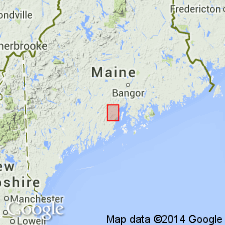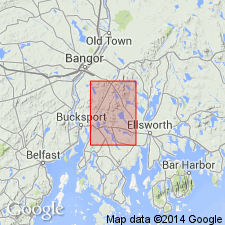
- Usage in publication:
-
- Mixer Pond Member
- Modifications:
-
- Named
- Dominant lithology:
-
- Gneiss
- AAPG geologic province:
-
- New England province
Summary:
Passagassawakeag Formation is here proposed to replace term Knox Gneiss of Perkins and Smith (1925). Unit is subdivided into a basal calc-silicate member (30-150 m) and the upper Mixer Pond Member (new name) (300 m). Mixer Pond described as light-gray to white, fine-grained, massive, and compositionally layered feldspathic gneiss composed of hornblende, biotite, ferrosalite, and magnetite. Isotopic dating of Passagassawakeag by Zartman (oral commun., 1974) and Brookins (1975, written commun.) ranges from 430+/-10 m.y. (Pb206-Pb207, zircons) to 600+/-80 m.y. (Rb-Sr).
Source: GNU records (USGS DDS-6; Reston GNULEX).

- Usage in publication:
-
- Mixer Pond Member*
- Modifications:
-
- Age modified
- AAPG geologic province:
-
- New England province
Summary:
Age of the Passagassawakeag Gneiss and its Mixer Pond Member of Bickel (1976) is Proterozoic(?) to Ordovician(?).
Source: GNU records (USGS DDS-6; Reston GNULEX).
For more information, please contact Nancy Stamm, Geologic Names Committee Secretary.
Asterisk (*) indicates published by U.S. Geological Survey authors.
"No current usage" (†) implies that a name has been abandoned or has fallen into disuse. Former usage and, if known, replacement name given in parentheses ( ).
Slash (/) indicates name conflicts with nomenclatural guidelines (CSN, 1933; ACSN, 1961, 1970; NACSN, 1983, 2005, 2021). May be explained within brackets ([ ]).

